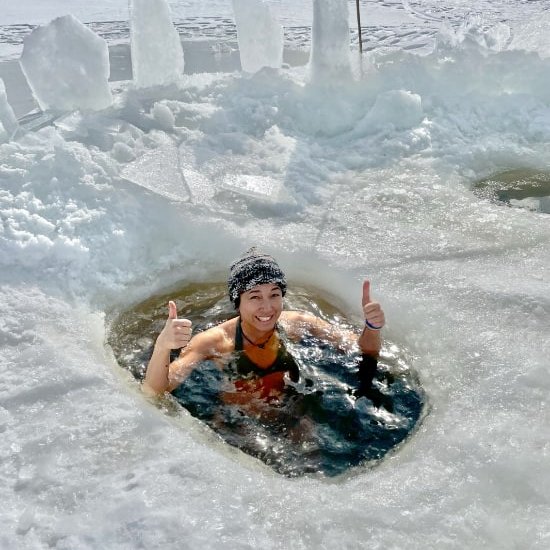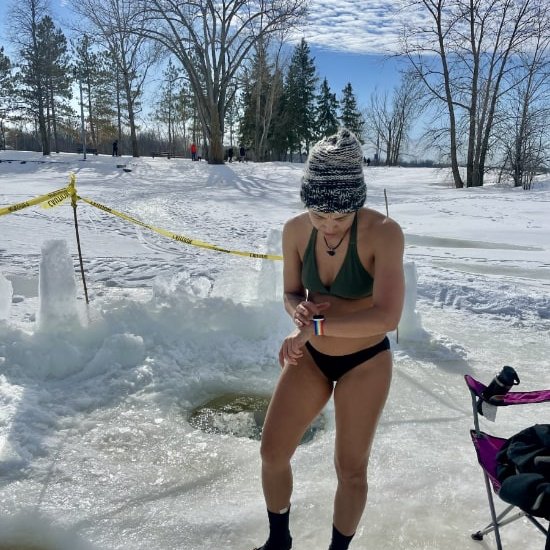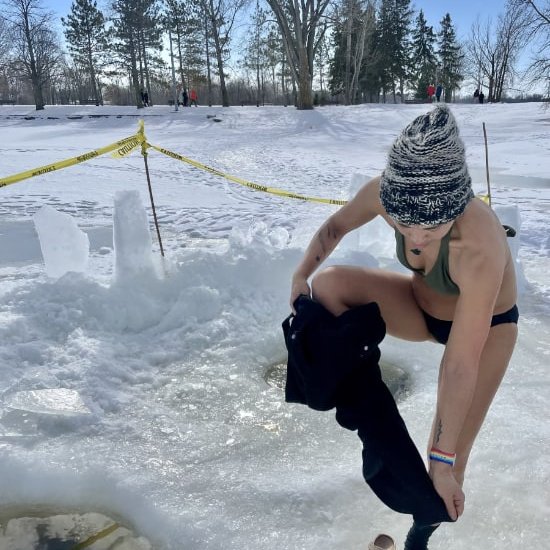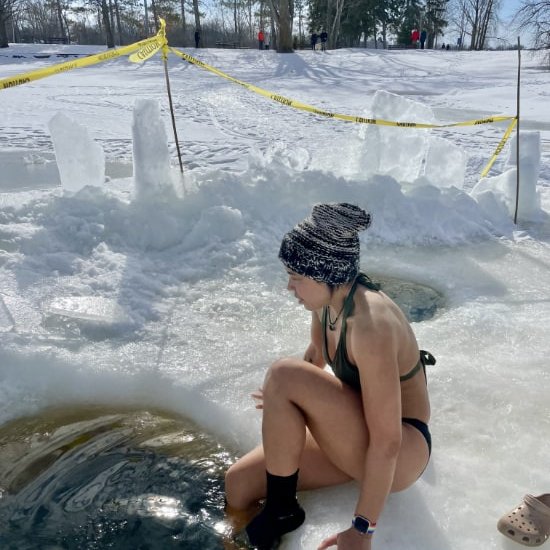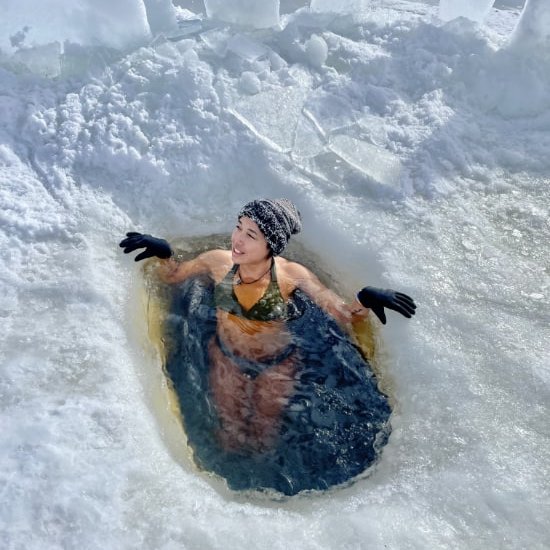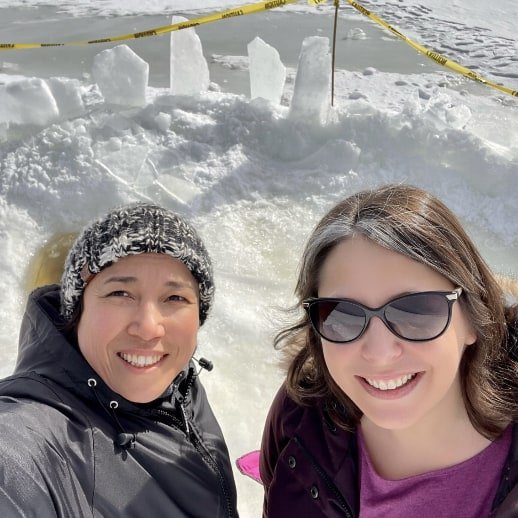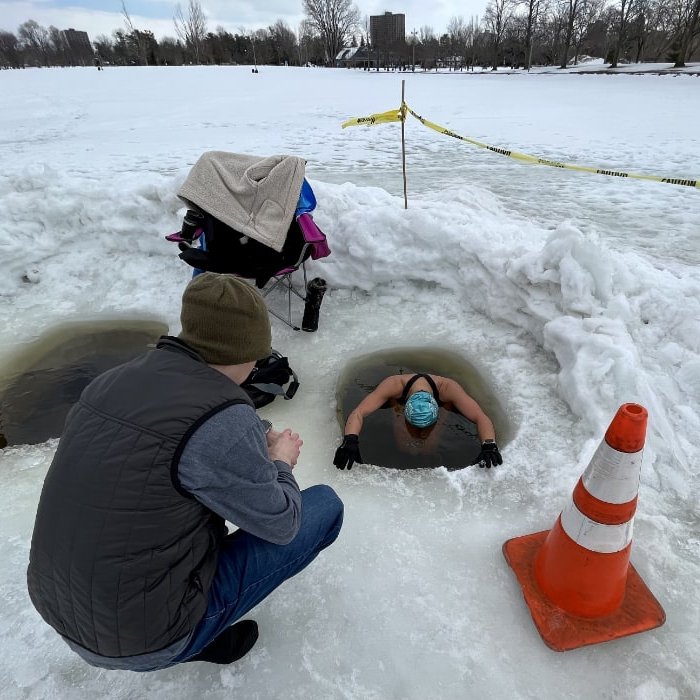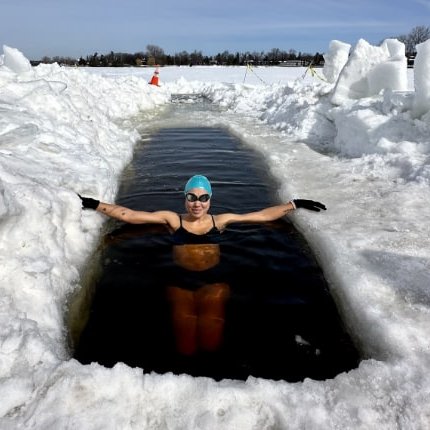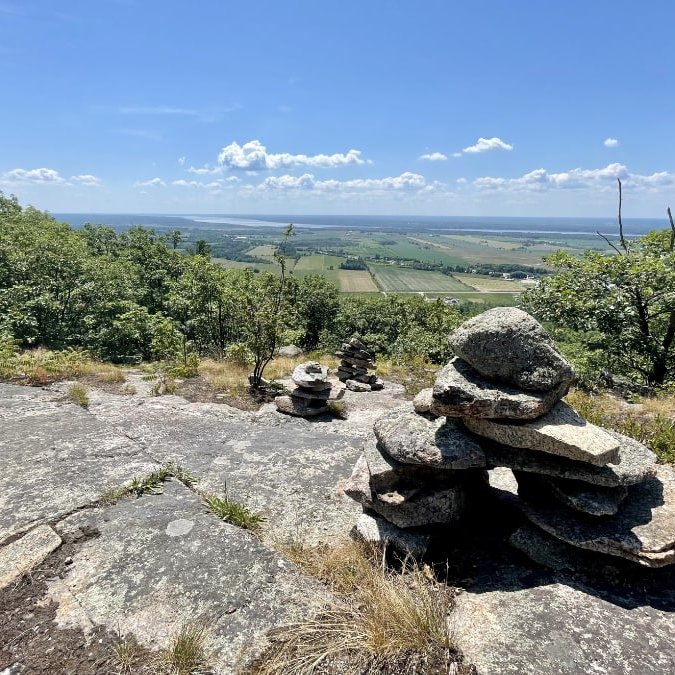A couple of weeks ago, I went for a walk with a friend at Britannia Bay Beach on a sunny winter day. Over the course of our walk, I noticed some people out on the ice, an area surrounded by safety tape and snow mounds. Curious, I went out to investigate and when I got closer, I noticed that a couple of the people were in bathing suits. This area was created by locals for the purposes of cold water immersion and swimming (yes, there was even a mini swimming lane cut into the ice!). I had no idea people did that in Ottawa, but was excited to try it myself.
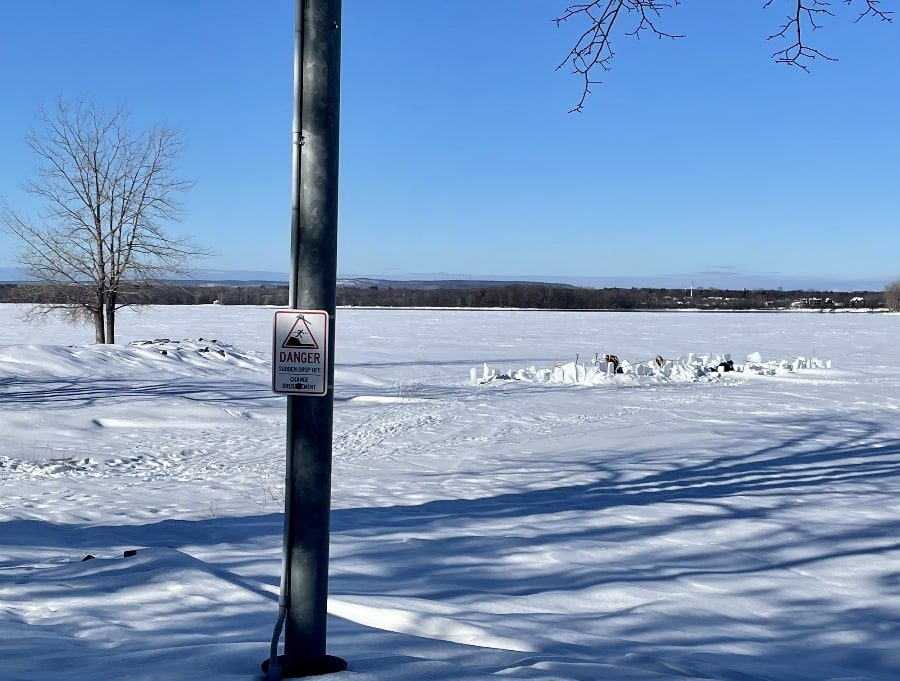
My Background in Cold Water Training
With my background in water stunts, I have been exposed to all sorts of different kinds of conditions, one of which is having to perform in cold water conditions, sometimes swimming tangled in a shower curtain (Dirk Gently's Holistic Detective Agency), sometimes being thrown in the water (Altered Carbon), sometimes diving in head first (Siren), and sometimes doing an underwater swim from the depths of a glacier-fed lake all the way to the surface, completely on breath hold (Keep Breathing). (*Check out the monitor footage of my free dive for Keep Breathing.).
I started out on this cold water journey taking the Oceanoid course "Introduction to Cold Water and Breath Hold for Stunt Performers and Safety Divers" led by my water stunt mentor Roberta Cenadese. With Roberta's encouragement and expert tutelage, I also completed the AIDA 2 free diving certification, and later even took up cold water swimming in the ocean with a group she led early in the pandemic.
The Risks of Cold Water Immersion
I would be negligent if I didn't point out all the risks in doing cold water immersion, making it abundantly clear, what is involved and why it's so important to approach it cautiously. To be clear, water that is 25C or less can be considered cold by those who are inexperienced, though most cold water swimmers consider anything under 10C to be cold. On the other hand, there are people who will have cold reactions to temperatures warmer than 25C. Every person is different. Either way, a person's body is more likely to have worse reactions to the cold when unaccustomed to it.
Cold water immersion is not to be taken lightly. No one should dive in head first. Ever. Figuratively and quite literally. Many people feel the best way to get into cold water is to just jump all the way in so you don't have time to think about it. This is the absolute worst way to do it. You'll understand why, as I dig into the details here.
Pain Reaction
Especially for those who are inexperienced, the first reaction you can confront is pain that most people describe as a burning. This can be quite intense, even overwhelming, and fear/stress can make it even worse. It's often felt more strongly in the hands and feet, and if your face is submerged, it will be hit with it even worse as it fills the nasal passages and sinuses. Imagine the worst ice cream headache you've ever had then multiply that ten-fold. You get the idea. The pain alone can be so bad that people can panic and do something potentially dangerous to try and escape it.
Cold Water Shock
Cold water shock lasts for the first few minutes after getting in, but can last longer if you're inexperienced or stressed. One of the dangers is the automatic gasp reflex that naturally happens when you get into cold water too quickly. This is the main reason why you should never jump or dive into cold water. The gasp can cause you to involuntarily inhale water, which can cause drownings. Even if you don't gasp, the body is also susceptible to hyperventilation during this period, which can lead to muscle spasms that can cause you to breathe in water, , experience dizziness, even fainting. Lastly, your body undergoes vasoconstriction, which causes blood to move from the limbs to the core, in an effort to keep your organs protected (the reason I wore gloves and socks for my immersion). This causes the heart to have to work harder to get the blood circulating around your body, which can lead to a cardiac event if you push yourself too hard before your body has moved through cold water shock.
A lot of people find they need to get out before reaching this point, especially if they're inexperienced with cold water. Roberta always reminds us that more people die of cold water shock than they do of hypothermia. This is why it's vitally important to take the time to allow your body to get over cold water shock before trying to immerse your face or swim.
The Afterdrop
After you get out of the water, the cold blood in the extremities begins to circulate and mix with the warm blood, causing the core body temperature to drop. It doesn't happen right away, which is why people usually don't start to shiver until 5-10 minutes after they get out of the water. It may be counterintuitive, but you don't want to warm the body too quickly as it can accelerate the afterdrop, which can be dangerous. You may feel like to vigorously towelling off or jumping into a hot tub or sauna, but this can cause the core temperature to drop too low, which can lead to a cardiac event.
Preparing for My Plunge
Even with all my background in doing cold water training and work, it had been at least 10 months since I'd done anything in cold water other than in the shower. Knowing that the water here is several degrees Celsius colder than even the coldest conditions I trained in out west, I took extra precautions so that it would go well on the day.
I took cold showers every day in the week leading up to it, staying in the water for several minutes at a time. It may be hard to believe, but doing is both mentally and physically more challenging for me than actually going all the way up to my neck in cold water. It's because the water is coming in the form of a shower rather than an immersion. I find that my body and mind isn't able to adapt as quickly as it does in an immersion, even though the water is warmer. So while this doesn't perfectly simulate the conditions of the ice water immersion, the act of committing the cold shower does help me practice my breath work and strengthen my willpower, helping to make it easier to stay calm on the day.
In addition to my cold showers, I paid attention to the weather. Cold air temperatures and windy or snowy weather conditions can make doing a cold water immersion more challenging in terms of the physical recovery. It also takes a hell of a lot more will power to go when it's not a nice, warm(ish), sunny day. I was originally going to do my immersion on the Saturday, but the temperature ended up being colder and the conditions windier. By waiting a day, I got to go on a sunny afternoon with no winds and a shore temperature of a balmy 1C.
In addition to going on a good weather day, I also wore my LavaCore polytherm glove and socks, as well as a warm hat while I was doing the immersion. Keeping your extremities warmer makes the experience easier on the system. I also had a bunch of warm fleece clothes and a diving coat to jump into as soon as I got out of the water and towelled off. Lastly, I made sure I had a friend with me for safety who was not doing an immersion (and also happened to be a nurse), to help me out in case I struggled with motor dysfunction after getting out of the water.
Britannia Bay on the Day
Even with all my prep work and prior experience doing cold water training, on the day, I was a little anxious about what it was going to feel like. It was my first time doing an immersion in 0C water that was cut into ice on a section of river that was frozen over. A small part of me would have breathed a sigh of relief if the weather had changed on the day, and that it was going to be too cold or too windy for me to tackle for my first time out. As it turned out, the conditions were about as ideal as they could be for mid-February in Ottawa. If I really wanted to do it, I had my perfect day. I had no excuses, so I put together all my gear and headed to Britannia Bay Beach to meet my friend.
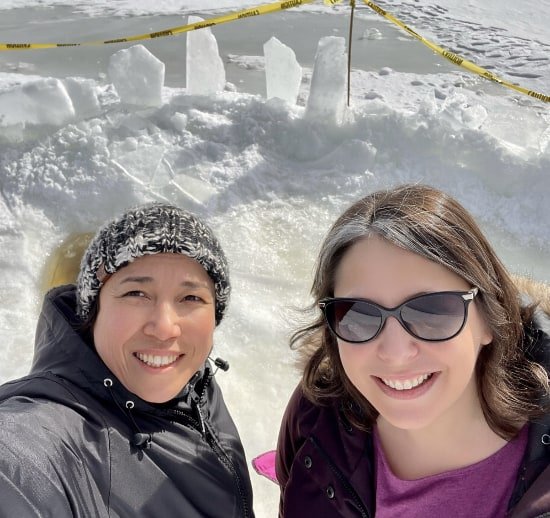
We went for an hour-long walk with me bundled up in all my warm clothes, to chat and catch up a bit, but also to get my core temperature warmed up before doing the plunge, something I learned to do in my training with Roberta, to help my body be better able to withstand the cold temperatures. With the weather being so warm, it didn't take long for me to feel like I was cooking in all my layers.
After the walk, we went back to my car to get all my gear to do the immersion. On top of the stuff I was wearing into the water, and the clothes to get into after exiting, this included the following: a large microfibre towel, a pair of Crocs that are easy to slip on and off, my swimming thermometer, a chair to make it easier to change after getting out of the water, a thermal mug of warm ginger tea to help me warm up after (ginger has thermogenic properties), and a couple of pairs of stick-on personal warmers to put on to my pants and shirt at the inner thighs and arm pits to help me gently rewarm after my immersion.
My First Cold Water Immersion on Ice
After thoroughly warming myself with our walk, and sipping on some of hot ginger tea, I approached the staging area on Britannia Bay. I set up my folding chair and laid out all warm dry clothes so that they would be easily accessible as soon as I got out. Once everything was set, I took off my diving coat, opened up the heat packs and stuck them on the outsides of my pants and shirt so that they would be ready to warm my the area around my inner thighs and arm pits after I got out. Once everything was in place, I took of my pants and top, leaving on nothing but my bikini, toque, and a thin pair of diving gloves and socks. I started a timer on my Apple Watch, kicked off my Crocs, then sat myself down on the ice, slowly easing my legs and torso into the icy cold water.

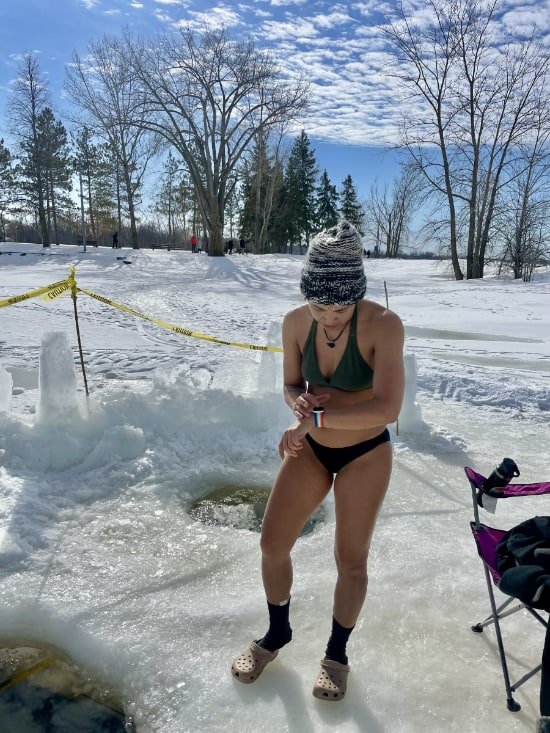

I was surprised that my body didn't have a gasp reflex, or at least not one that was strong enough that I noticed it. I was even more surprised, that it actually felt pleasant. I felt quite calm, while at the same time, hyper-aware of my surroundings. It felt like I had immediately gone into a meditative state. While I was in the water, the safety partner of a cold water swimmer who had just gotten out, chatted with me, commenting that it was rare for him to see someone that calm right off the top. It then occurred to me that even though I hadn't been consistently doing cold water immersion training for a while, I have been doing regular meditation and breathwork. On top of that, I do trust in my knowledge and experience. I know what to expect in terms of reactions in the body and mind, and having that at the back of my mind helped me stay calm.

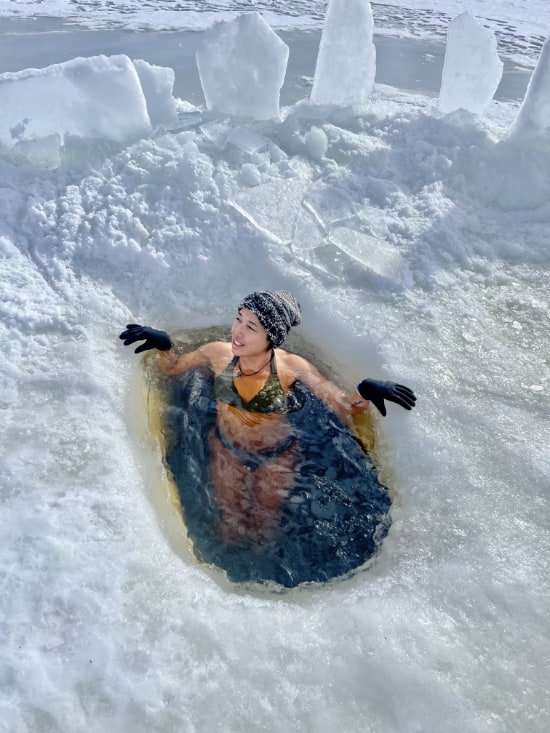
I was so relaxed in the water that time flew by. My goal was to stay in the water at least one minute, but if I was feeling good, I would stay in the water longer. I hoped to make it to 3 minutes, not really expecting to last much longer than that. I did, however, give myself an outside time of no longer than 5 minutes, even if I still felt good at that time. I was so at peace in the water, noticing the sun reflecting off the snow and ice, feeling the camaraderie with the other swimmer and our safety partners. The present moment awareness was awe-inspiring. The serenity I was experiencing made it tempting to stay in longer, but bad things happen when you push yourself too far, too fast.
Exiting the Water
To my surprise, I made it to 5 minutes and cut myself off there. I eased myself toward the edge of the ice, then slowly pulled myself from the water. My friend handed me my towel and I went through my checklist.
- Remove my gloves and gently pat dry off my core, squeezing out excess water from my swim suit.
- Sit in the chair and take off my wet suit socks and pat my dry my arms and legs (no vigorous rubbing!).
- Pull on my fleece pants, fleece top, dry socks, boots, and diving coat.
- Sip my warm ginger tea while I pack everything up to go.
- Walk carefully back to the car with the help of my friend as needed.
- Turn on the car and warm back up for 10-15 minutes, or until shivering has stopped and mobility is regained, sipping on my tea and eating a snack while I wait.
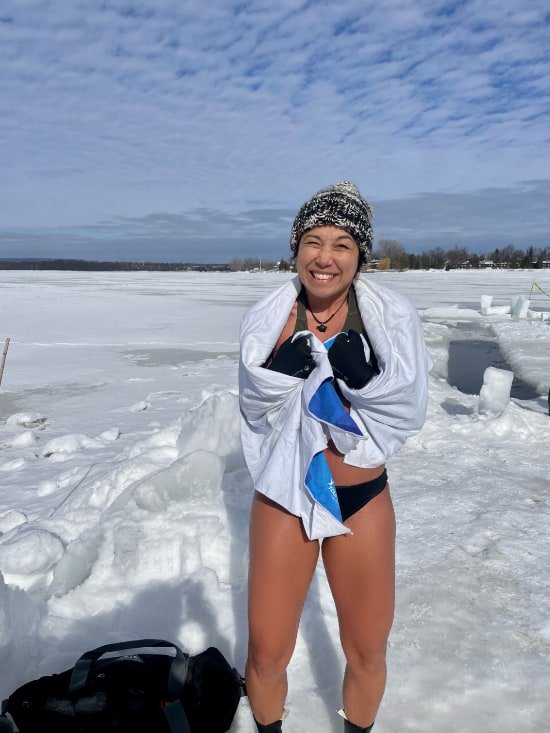
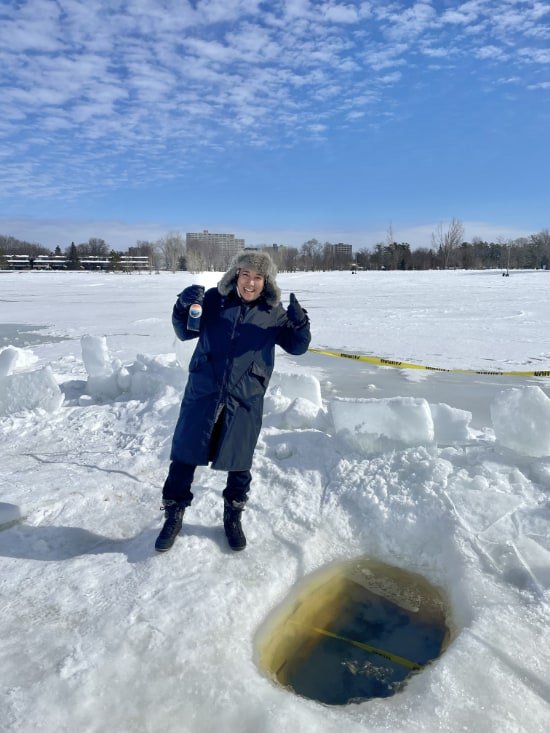
The After Effects of My Ice Plunge
Just as I finished packing up to head back to the car, around 7 minutes after getting out of the water, I started to shiver. The afterdrop was kicking in. We walked back to the car, loaded it up, and got in. I felt so at peace, so in the moment. I felt connected with my friend and very much appreciating my life and precious that present moment was.
I've read many accounts of the health benefits of doing cold plunges, including improved immunity, reduction of inflammation, shortened recovery times from workouts, increases in metabolism, etc. But the ones I noticed most were the mental benefits, the increased focus and clarity, the dropping away of all the mental chatter that keeps you from being in the moment. I've read reports of dopamine release resulting from cold water immersion. I'd believe it. I felt so good in the water and for all the rest of the day. This is probably why it is also reported that cold water immersion helps ease depression and anxiety.
The biggest effect lingering effect for me was the desire to get back there and do it again the next opportunity I have. It's hard not to want to after an experience like that!
Now over to you. Have you dabbled in cold water immersions? If so, what have your experiences been like? Please feel free to share in the comments.

